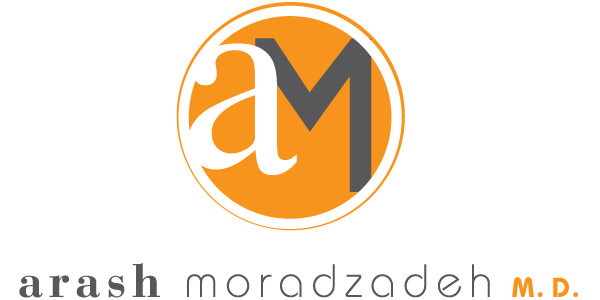
A deviated septum can make breathing feel like a struggle every day. You may experience chronic congestion, snoring, sinus infections, disrupted sleep and other symptoms that diminish your quality of life. While nasal sprays and over-the-counter remedies may give you short-term relief, they often fail to address the root of the problem.
Septoplasty is a proven, long-term solution that, when performed by an expert, can dramatically improve your quality of life. At AM Facial Plastics in Beverly Hills, Dr. Arash Moradzadeh, a dual board-certified ENT and facial plastic surgeon, brings advanced training and a breadth of experience to every septoplasty procedure. His approach combines functional expertise with meticulous attention to detail so you can breathe freely and comfortably again.
What Is Septoplasty?
Septoplasty is a surgical procedure to correct a deviated septum. Your septum is the cartilage and bone structure that divides your nasal passages. When it is significantly off-center, it can block airflow through one or both of your nostrils, leading to:
- Chronic nasal congestion
- Difficulty breathing through your nose
- Frequent sinus infections
- Snoring or disrupted sleep
- Headaches or facial pressure
Benefits of Septoplasty
Easier Breathing Through Your Nose
Septoplasty straightens the nasal septum, opening blocked airways and restoring balanced airflow through your nostrils. This can make breathing noticeably easier, especially while you’re sleeping or engaged in physical activity.
Better Sleep Quality
By improving airflow, septoplasty reduces nighttime breathing disruptions such as snoring or mild sleep apnea symptoms. Many patients report deeper, more restful sleep after surgery.
Fewer Sinus Infections
A properly aligned septum improves sinus drainage. This reduces the risk of mucus buildup and recurring infections, and leads to fewer episodes of sinus pressure, congestion, and discomfort.
Relief From Nasal Blockage or Pressure
Chronic nasal obstruction and facial pressure are commonly linked to a deviated septum. Septoplasty relieves this blockage at the source, helping you feel more comfortable throughout the day.
No Change to External Appearance
Septoplasty focuses solely on internal nasal structures and does not affect the shape or look of your nose. If you desire cosmetic changes as well, a combined procedure called septorhinoplasty may be recommended.
Permanent Structural Correction
Unlike medications that temporarily manage symptoms, septoplasty offers a long-term solution by correcting the underlying anatomical problem. Most patients enjoy lasting relief after a single procedure.
Minimal Downtime
Recovery from septoplasty is relatively quick. Most patients return to work and daily activities within seven to ten days. Post-operative discomfort is typically mild and manageable with over-the-counter medication.
Septoplasty vs. Other Treatments
Dr. Moradzadeh makes sure you understand all your options for achieving long-term relief from nasal obstruction or breathing issues. Septoplasty addresses the root cause of many structural problems, but it’s often confused with other procedures or combined with complementary procedures for optimal results.
Septoplasty vs. Rhinoplasty
Septoplasty is a functional procedure designed to straighten the internal nasal septum to improve airflow. It is typically performed for medical reasons, such as chronic congestion, sinus infections, or breathing difficulties.
Rhinoplasty is primarily cosmetic, meaning it is intended to enhance the external appearance of the nose. It achieves this by modifying the nose’s shape, size, symmetry, or proportions to better complement the face.
Septoplasty vs. Turbinate Reduction
Septoplasty corrects a deviated septum, the bony and cartilaginous structure dividing your nasal passages. When the septum is misaligned, it can obstruct one or both nostrils.
Turbinate reduction addresses the soft tissues inside the nose, specifically the turbinates, which are small structures that humidify and filter the air you breathe. When turbinates become swollen (often due to allergies or chronic irritation), they can contribute to nasal blockage even if your septum is straight.
Many patients suffer from both issues simultaneously. In such cases, a combination of septoplasty and turbinate reduction offers a more comprehensive and lasting solution.
Septoplasty vs. Nasal Strips, Decongestants, and Sprays
Nasal strips, antihistamines, and decongestant sprays (like oxymetazoline) offer temporary relief from your symptoms by physically or chemically opening your nasal passages.
However, these solutions do not address the structural deformities, such as a deviated septum, causing your symptoms. Overuse of decongestant sprays can even lead to rebound congestion or long-term dependency (known as rhinitis medicamentosa).
Septoplasty is the definitive treatment when physical obstruction from a deviated septum is the root cause. It offers permanent correction of the internal architecture of your nose, eliminating the need for ongoing medication or external aids.
What to Anticipate for Septoplasty
Initial Consultation
During your consultation, we will review your symptoms and evaluate the inside of your nose. We may order imaging to assess the extent of septal deviation more thoroughly. Dr. Moradzadeh will guide you through your options and provide a personalized recommendation tailored to your anatomy and goals.
The Procedure
Septoplasty is performed under local or general anesthesia, depending on your needs. It typically takes between 30 and 90 minutes. Dr. Moradzadeh makes incisions inside your nostrils, ensuring you’re left with no visible scars, and then reshapes or repositions the deviated septum. In some cases, septoplasty may be combined with a turbinate reduction or a cosmetic rhinoplasty for a more an enhanced result.
Recovery and Downtime
Most patients return home the same day. Expect mild swelling, nasal congestion, and fatigue for the first week. You’ll likely return to normal activities within seven to ten days, although strenuous exercise should be avoided for two weeks.
Who Is a Good Candidate for Septoplasty?
You may be a strong candidate for septoplasty if you:
- Have been diagnosed with a deviated septum
- Experience ongoing nasal obstruction
- Snore heavily or suffer from poor sleep
- Have difficulty breathing through one or both nostrils
- Seek long-term relief from chronic sinus symptoms
Septoplasty is ideal for men and women of all ages. It’s particularly common among athletes, actors, models, and public-facing individuals whose breathing, speech, or stage presence may be affected. Our team provides a customized recovery plan to ensure your comfort and results.
How Long Do the Results of Septoplasty Last?
Septoplasty is typically a one-time procedure with permanent results. Once the septum is repositioned and healed, most patients enjoy lifelong improvements in airflow and nasal function.
That said, the healing process can vary slightly from person to person. You’ll receive a detailed follow-up plan with regular check-ins to ensure optimal healing and sustained results.
How Much Does Septoplasty Cost?
The total cost of septoplasty can vary significantly depending on your specific anatomy, the complexity of your case, the provider you choose, and whether your surgery is performed on its own or in combination with other procedures like turbinate reduction or rhinoplasty. Because septoplasty is a highly personalized surgery aimed at correcting internal nasal structure, providing a fixed price range without an evaluation is often inaccurate.
Meeting with Dr. Moradzadeh at AM Facial Plastics is the most reliable way to understand what your treatment will involve and what it may cost based on your goals, medical needs, and procedural plan.
When it comes to insurance, coverage for septoplasty is more common than for cosmetic procedures. In many cases, if the surgery is performed to correct a deviated septum or relieve chronic breathing issues, part or all of the cost may be covered by your insurance provider. We recommend confirming coverage in advance, and our team is happy to assist you with documentation or preauthorization if needed.
Frequently Asked Questions About Septoplasty
Will septoplasty alter the appearance of my nose?
Septoplasty is designed to correct internal structural issues, such as a deviated septum, and is performed entirely inside the nose with no external incisions. In most cases, it does not change the outward appearance.
However, if you have visible asymmetry, a crooked nose, or if you’re interested in refining nasal shape, cosmetic rhinoplasty can be performed at the same time. This combined approach is ideal for patients who wish to address both airflow and appearance in a single surgical plan.
Is the surgery painful?
Septoplasty is generally well tolerated. Most patients experience mild to moderate discomfort, often described as sinus pressure or congestion, rather than sharp pain. You may feel fatigued for a few days and experience swelling or stuffiness, especially if splints are placed inside the nose. Dr. Moradzadeh provides a tailored recovery plan that includes prescription medications, cold compresses, and post-operative guidance to keep you as comfortable as possible.
How soon can I return to work?
Most patients can return to desk work or light activity within 7 to 10 days, while those in physically demanding jobs may need up to two weeks to recover. You’ll likely feel congested at first, but visible swelling is usually minimal. Dr. Moradzadeh provides clearance on a case-by-case basis, ensuring your return to work is both safe and manageable.
Can I combine septoplasty with other treatments?
Absolutely. Septoplasty is commonly performed alongside:
- Turbinate reduction – to further open the airway
- Cosmetic rhinoplasty – for aesthetic refinement
- Facial aesthetic treatments, such as AviClear for acne, laser resurfacing, or injectables
This is especially popular among our West Hollywood and on-camera clientele, who want to address both internal function and outward appearance in a cohesive treatment plan. Our team can coordinate the timing of these treatments for optimal healing and results.
What if I’ve had nasal surgery before?
If you’ve had a prior septoplasty or rhinoplasty and still struggle with breathing issues, you may benefit from a revision septoplasty. Dr. Moradzadeh specializes in complex and secondary nasal surgeries, and he’ll perform a thorough evaluation, including nasal endoscopy or imaging if needed, to assess scar tissue, residual deviation, or unresolved anatomical issues. Many patients find their best outcomes through a carefully planned revision approach.
Why Choose AM Facial Plastics for Your Septoplasty?
Choosing the right surgeon for your septoplasty can mean the difference between short-term relief and long-term, life-enhancing results. At AM Facial Plastics in Beverly Hills, patients receive care from one of the country’s most accomplished facial plastic surgeons: Dr. Arash Moradzadeh.
Dr. Moradzadeh is a dual board-certified surgeon in both ENT/head and neck surgery and facial plastic and reconstructive surgery, a distinction held by only a select group of physicians nationwide. With advanced fellowship training, extensive experience, and a reputation for innovation, he is a trusted authority in both functional and aesthetic nasal surgery.
Today, patients from across Los Angeles, Santa Barbara, West Hollywood, and around the world trust Dr. Moradzadeh for his surgical artistry, clinical expertise, and personalized care. Whether you’re a resident or an international visitor, you can expect discreet, world-class treatment tailored to your specific needs and goals.
The First Step Toward Breathing Freely Again With Septoplasty
If chronic nasal congestion, mouth breathing, or restless sleep is interfering with your quality of life, septoplasty offers a long-term solution. When performed by an expert in both function and form, this procedure can restore your ability to breathe clearly, day and night.
At AM Facial Plastics, we deliver meticulous, discreet care for patients across Los Angeles and Beverly Hills, as well as those traveling from Santa Barbara, out of state, or internationally. Whether you’re seeking subtle internal correction or combining your surgery with aesthetic enhancements, you’ll receive the highest level of surgical precision and personalized support.
Request your private consultation with Dr. Moradzadeh today. We welcome individuals from all walks of life who seek natural, functional results. Discover the expertise, comfort, and results that set AM Facial Plastics apart.


